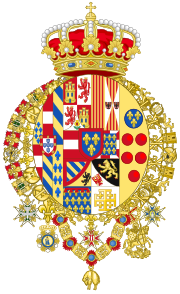
Back Неапалітанскія Бурбоны Byelorussian Бурбон-Сицилия Bulgarian Bourbon-Obojí Sicílie Czech Bourbon-Sizilien German Οίκος των Βουρβόνων-Δύο Σικελιών Greek Casa de Borbón-Dos Sicilias Spanish Maison de Bourbon-Siciles French Burbonci Dviju Sicilija Croatian Borbone delle Due Sicilie Italian シチリア・ブルボン朝 Japanese
This article needs additional citations for verification. (April 2018) |
| House of Bourbon-Two Sicilies | |
|---|---|
 | |
| Parent house | House of Bourbon-Anjou |
| Country | Kingdom of the Two Sicilies |
| Founded | 1759 |
| Founder | Ferdinand I of the Two Sicilies |
| Current head | Disputed: Prince Pedro, Duke of Calabria Prince Carlo, Duke of Castro |
| Final ruler | Francis II |
| Titles | King of Naples, King of Sicily, King of the Two Sicilies |
| Deposition | 1861 |
The House of Bourbon-Two Sicilies is a cadet branch of the House of Bourbon that ruled Southern Italy and Sicily for more than a century in the 18th and 19th centuries. It descends from the Capetian dynasty in legitimate male line through Philip, Duke of Anjou (later Philip V of Spain), a younger grandson of Louis XIV of France (1638–1715) who established the Bourbon dynasty in Spain in 1700 as Philip V (1683–1746). In 1759, King Philip's younger grandson was appanaged with the kingdoms of Naples and Sicily, becoming Ferdinand IV and III (1751–1825), respectively, of those realms. His descendants occupied the joint throne, merged as the "Kingdom of the Two Sicilies" in 1816, until 1861, claimed it thereafter from exile, and constitute the extant Bourbon-Two Sicilies family.
The succession of the House of Bourbon-Two Sicilies has, since 1960, been disputed between the senior Calabrian line, which is currently being represented by Prince Pedro, Duke of Calabria (born 1968) and the junior Castro line, which is currently being represented by Prince Carlo, Duke of Castro (born 1963). Efforts of reconciliation were carried out in 2014, but have been followed by continuing arguing in the family as Prince Carlo, Duke of Castro, abolished the law of male primogeniture to absolute primogeniture in 2016, making her eldest daughter heir by going against the tradition of male-line succession within the House of Bourbon-Two Sicilies.[1]
- ^ Grouard, Salomé. "Princesses Maria Carolina and Maria Chiara on what it means to be a modern princess". Tatler Asia. Retrieved 11 January 2025.